Karin Luts
Karin Luts (29 April 1904 – 14 May 1993) was an Estonian painter and a graphic artist.[1][2][3]
Karin Luts | |
|---|---|
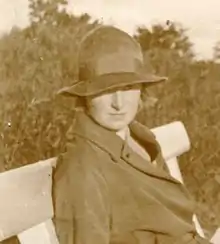 | |
| Born | 29 April 1904 |
| Died | 14 May 1993 (aged 89) Stockholm, Sweden |
| Nationality | Estonian |
| Spouse | Peeter Arumaa |
| Relatives | Meta Luts (sister) Julius Gentalen (cousin) |
Biography
Karin Luts was born in Riidaja in Valga County to parents Andres and Juuli Mari Luts (née Gentalen) in April 1904 where she was one of three sisters, Lonny, Meta and Karin, and a brother Elmar. Her father was a teacher. She completed her studies in Pärnu Estonian School Society Progymnasium in 1922. She had studied under artist Konstantin Süvalo. Luts then went to the Art College in Pallas, Tartu to study with Konrad Mägi. When Mägi died she continued with Ado Vabbe. Luts learned etching and lithography from Magnus Zeller. Luts graduated in 1928. In 1928 Luts spent a year at the Académie de la Grande Chaumière with André Lhote before returning to Estonia to work as an artist in Tallinn.[4][5][6][7][8][9][10]
Luts worked as a costume designer and illustrator. One of her works was the illustrations for Eduard Visnapuu's children's book "Loomade talu" in 1933. She began to work with textile designs in 1935. The Ministry of Economy commissioned her to complete a tapestry design to be displayed in the Estonia pavilion of the Paris World's Fair in 1937. The work won a gold medal. She traveled to Finland and Denmark with Andrus Johani before she published her first article. Luts article was a critic of an exhibition of Italian women artists held in Tallinn in 1937. By 1939 Luts was part of the group of artists known as Pallas.[1][9][10]
In 1939 Luts traveled through Rome with the Tallinn Women's Club where she took the opportunity to work in the studio of the artist Countess Mola. She had planned to return to Rome but the outbreak of the Second World War prevented it. She began working for the Konrad Mägi College of Art in 1940 as a lecturer. She married fellow professor Peter Arumaa and in 1944 they fled the soviet occupation of Estonia and went to Sweden. They both became citizens in the 1950s.[5][6][8][9][10]
In Sweden Luts took up graphic design and gained recognition in painting and graphics internationally though she died relatively unknown having left Estonia as one of her best known women artists. She studied graphics from 1960 to 1968 in Stockholm and went on to study in Salzburg. She died in Stockholm in 1993. She left her art to the Tartu Art Museum and her writings to the Estonian Literary Museum.[5][6][7][8][9][10][11]
Luts was married to linguist Peeter Arumaa. Her sister was the actress Meta Luts and her cousin was artist Julius Gentalen.[12][10]
Works
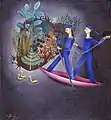 Kompositsioon. Õnnesaar, 1927
Kompositsioon. Õnnesaar, 1927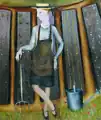 Aednik, 1928
Aednik, 1928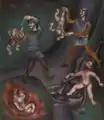 Süüta laste tapmine, 1928
Süüta laste tapmine, 1928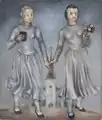 Leerilapsed, 1936
Leerilapsed, 1936 Kaluritüdruk rannal, 1943
Kaluritüdruk rannal, 1943 Self-portrait, 1943
Self-portrait, 1943
References
- Torn, Vilve. "7 põnevat fakti: müts maha iseseisva naise ees". Naisteleht (in Estonian). Retrieved 2020-06-17.
- Guides, I. (2019). Insight Guides Estonia, Latvia & Lithuania. Insight Guides. Apa Publications. p. 127. ISBN 978-1-78919-829-4. Retrieved 2020-06-17.
- Rosenfeld, A.; Dodge, N.T.; Dodge, N.C.; Jane Voorhees Zimmerli Art Museum (2002). Art of the Baltics: The Struggle for Freedom of Artistic Expression Under the Soviets, 1945-1991. Dodge Soviet nonconformist art publication series. Rutgers University Press. p. 41. ISBN 978-0-8135-3042-0. Retrieved 2020-06-17.
- "Juured hargnesid Riidajast pärit õdede radadele". Lõuna-Eesti Postimees (in Estonian). 2006-06-13. Retrieved 2020-06-17.
- "Karin Luts jõudis koju tagasi". Estonian World Review (in Estonian). 2004-10-15. Retrieved 2020-06-17.
- "Karin Luts". AWARE Women artists / Femmes artistes. 2018-03-18. Retrieved 2020-06-17.
- "Karin Luts". teosed E-kunstisalongis (in Estonian). Retrieved 2020-06-17.
- "Karin Luts. Konfliktid ja pihtimused". Tartmus (in Estonian). 2017-07-06. Retrieved 2020-06-17.
- "Karin Luts: an artist and her time". Karin Luts: an artist and her time. 2008-12-19. Retrieved 2020-06-17.
- "Luts, Karin". Eesti Entsüklopeedia (in Estonian). Retrieved 2020-06-17.
- Taylor, N. (2014). Estonia. Bradt Travel Guide Estonia (in Spanish). Bradt Travel Guides. p. 43. ISBN 978-1-84162-487-7. Retrieved 2020-06-17.
- Zirin, M.; Livezeanu, I.; Worobec, C.D.; Farris, J.P. (2015). Women and Gender in Central and Eastern Europe, Russia, and Eurasia: A Comprehensive Bibliography Volume I: Southeastern and East Central Europe (Edited by Irina Livezeanu with June Pachuta Farris) Volume II: Russia, the Non-Russian Peoples of the Russian. Taylor & Francis. p. 2880. ISBN 978-1-317-45196-9. Retrieved 2020-06-17.